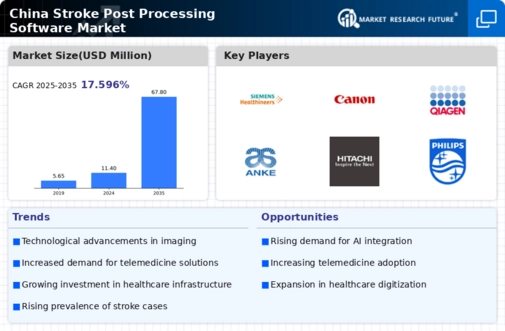Rising Incidence of Stroke Cases
The increasing prevalence of stroke cases in China is a primary driver for the stroke post-processing-software market. According to recent health statistics, stroke remains one of the leading causes of mortality and disability in the country. The World Health Organization indicates that approximately 2.5 million people in China suffer from strokes annually, which necessitates advanced diagnostic and treatment solutions. This growing patient population creates a substantial demand for innovative software that can enhance imaging analysis and improve clinical outcomes. As healthcare providers seek to adopt more efficient technologies, the stroke post-processing-software market is likely to experience significant growth, driven by the urgent need for effective post-stroke care and rehabilitation solutions.
Technological Advancements in Imaging
Technological innovations in imaging modalities, such as MRI and CT scans, are propelling the stroke post-processing-software market forward. Enhanced imaging techniques provide clearer and more detailed visuals, which are crucial for accurate diagnosis and treatment planning. The integration of advanced algorithms and machine learning capabilities into imaging software allows for faster and more precise analysis of stroke-related data. In China, the market for medical imaging is projected to reach approximately $10 billion by 2026, indicating a robust growth trajectory. This surge in imaging technology adoption is expected to drive demand for specialized post-processing software that can effectively interpret complex imaging data, thereby improving patient outcomes.
Growing Awareness of Stroke Prevention
There is a rising awareness regarding stroke prevention and management among the Chinese population, which is influencing the stroke post-processing-software market. Public health campaigns and educational programs are increasingly focusing on the importance of early detection and timely intervention. As individuals become more informed about stroke risk factors and symptoms, the demand for diagnostic tools and software that facilitate early diagnosis is expected to grow. This heightened awareness is likely to drive healthcare providers to invest in advanced post-processing solutions that can aid in the swift identification of stroke cases, thereby enhancing overall healthcare outcomes.
Increased Investment in Healthcare Technology
Investment in healthcare technology is on the rise in China, which serves as a significant driver for the stroke post-processing-software market. Both public and private sectors are channeling funds into the development of innovative healthcare solutions, including software that enhances stroke diagnosis and treatment. Reports suggest that healthcare technology investments in China could exceed $20 billion by 2025, reflecting a strong commitment to improving healthcare delivery. This influx of capital is likely to stimulate advancements in stroke post-processing software, enabling the creation of more sophisticated tools that can support clinicians in making informed decisions and improving patient care.
Government Initiatives for Healthcare Digitization
The Chinese government is actively promoting healthcare digitization, which significantly impacts the stroke post-processing-software market. Initiatives aimed at enhancing digital health infrastructure are being implemented, with substantial investments allocated to modernize healthcare facilities. The government has set ambitious goals to improve healthcare accessibility and efficiency through technology. For instance, the Healthy China 2030 initiative emphasizes the integration of digital solutions in healthcare delivery. This supportive regulatory environment is likely to foster innovation and encourage the development of advanced stroke post-processing software, ultimately leading to improved patient care and operational efficiencies within healthcare systems.


















Leave a Comment